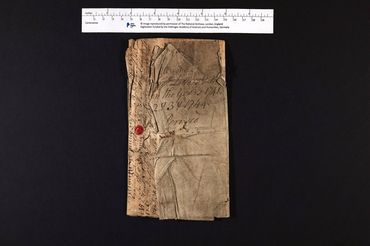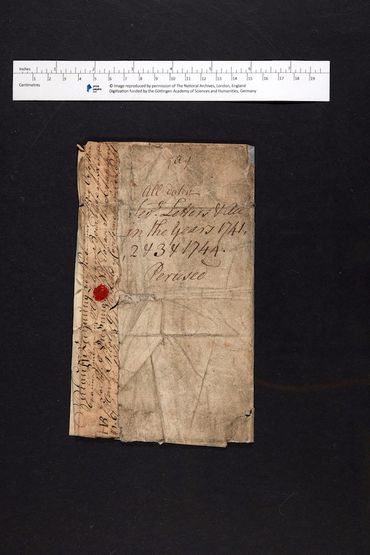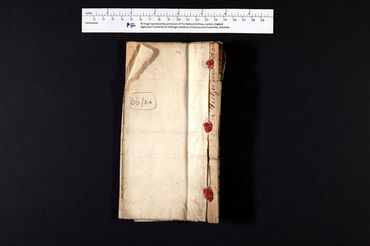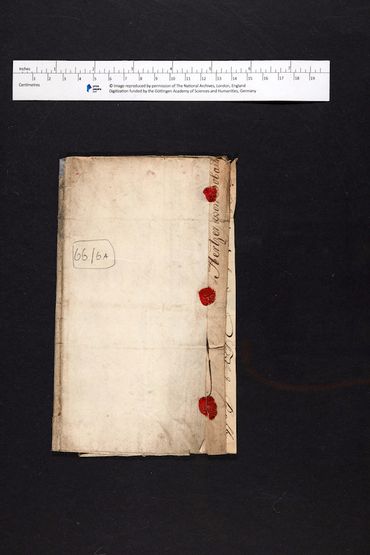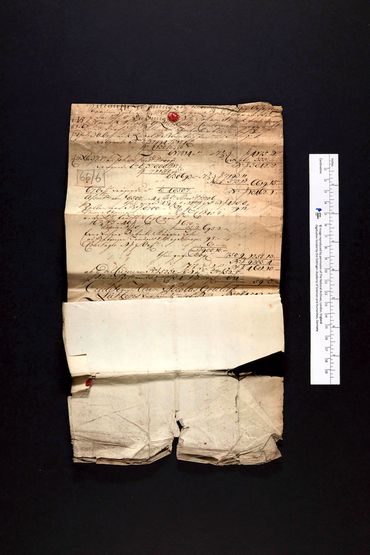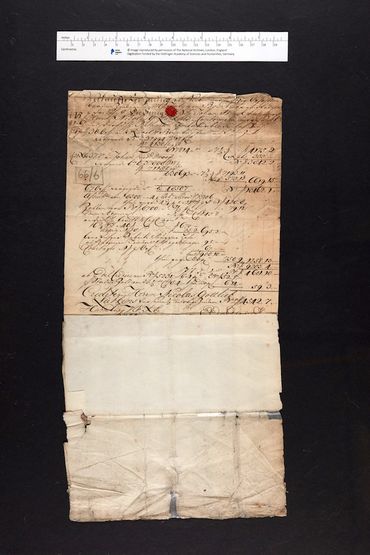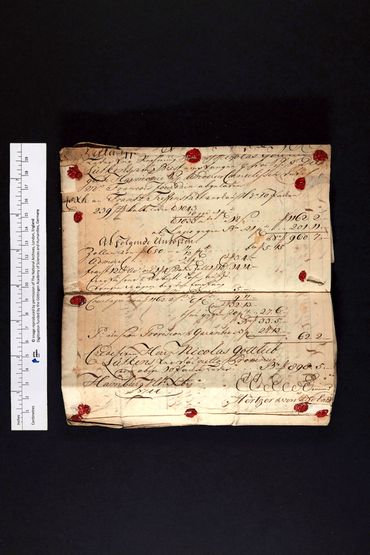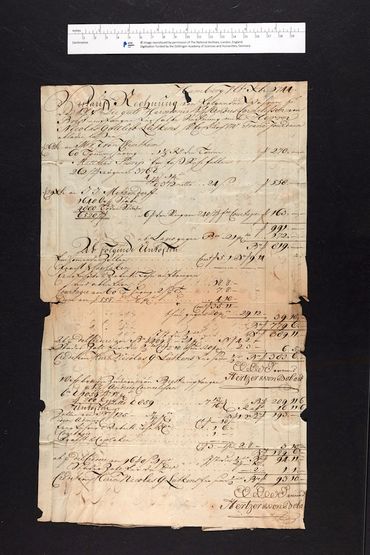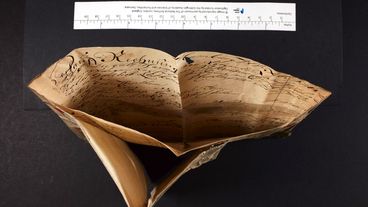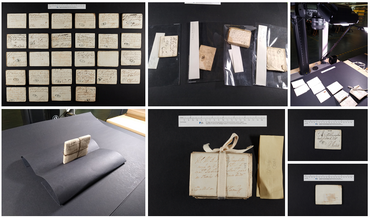Documentaries
Documentaries
Documentary I
Materiality shooting of TNA, HCA 30/236, 66/6A
A sealed invoice
Sorting team: Account of Hertzer, 1744, folded by the court to form a wrapper, with a court note 'Letters ... 1741...44 Perused' attached by wax seals
Oldenburg team: This document represented an important piece of evidence during the court proceedings regarding the allegedly neutral ship "Hoffnung" owned by Hamburg merchant Nicolaus Gottlieb Luetkens. It represents an original sales invoice ("Verkaufs=Rechnung") for goods found on board the captured ship, signed by the Hamburg merchant house of Hertzer & von Bobartt, in German language. During the court proceedings this piece of evidence was translated into English. The original sales invoice was stored and sealed with several seals by the High Court of Admiralty and transferred to the registry of the court.
Conservation team: The item is an enclosed envelope made from an account letter/invoice and red seals. The outer folio was originally wrapped around the letter and sealed into place by the court, this exhibits the most significant damage to the item.
Documentary II
Preparatory work and imaging of still sealed letters:
In June 2019, during Sorting and In-Depth cataloguing of item TNA, HCA 32/111: Capture of Le Fort de Nantes or El Fuerte, including the re-housing of corresponding files from several HCA 30 boxes, Amanda Bevan and Randolph Cock from the TNA Prize Papers Sorting team found 319 still sealed letters originally representing Mail in Transit stored on the ship, original kept in mailbags.
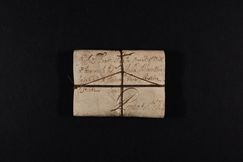

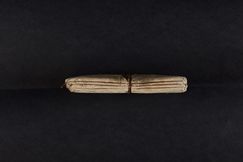

Letter package, still sealed and tied up with a string, TNA, HCA 32/111E
After careful consideration among the project partners in London and Oldenburg and in order to allow for more in-depth cataloguing, the Prize Papers Project has decided to open some of the letters. The majority of these letters, however, have not been opened and are therefore remaining in their original closed state till today. These letters have been imaged by the Prize Papers Project as still sealed letters.
The detailed catalogue of TNA, HCA 32/111E, which is the new reference number, with detailed information to all the letters can now be found here. On this page, for documentary purposes, we present some of the procedures following the decision to open closed letters.
This report is compiled by Lucas Haasis on the basis of the detailed reports by Maria Cardamone, Camilla Camus-Doughan, and Randolph Cock. Before further action was taken, the Imaging Team received the letters in order to produce Before Treatment Materiality Shots (BTMS). Imaging also documented all further steps taken during the opening procedure.
Imaging team in cooperation with Oldenburg
When doing a BTMS, I am given all the letters with a pre-sorting reference number. Because these letters are still closed, these letters cannot receive their final reference-number by Prize Papers sorting yet. Letters from mailbags are usually tied up in bundles, which were not original, because originally these letters were stored loosely in the mail-bags. These bundles are created by Conservation Care depending on which conservation procedure will be required to open the different types of seals. Before starting the actual shooting, I always do a colour correction, using the colour checker. This ensures the right colour for our images. If the letters belong to a bundle, then I shoot all of them in a display which records the number order. I display them leaving equal gaps on their sides, and I shoot using a wide-angle lens in order to fit all of them in one shot (this would decrease the time for shooting). I capture front and back of letters as Panorama Shots. When showing the back of letters, the flipping of letters is done from left to right to avoid turning them upside down. In this way, the right position of the seal on the letter folding is preserved in our images. If a letter is identified as special due to some of its features, I take extra Materiality Shots of the single letter, eventually from all the interesting sides. The pictures below show one of the peculiar letter packages from this letter collection with an interesting letter locking technique. Three letters are bound together by string, representing an early modern Lock-N technique, which delineates the process when other materials than the letter paper itself are used for locking letters and letter packages (DoLL 2019). For capturing the side of this particular letter I created a holder by using black cardboard and glass weights. This system allows me to avoid having one side of the letter lying down on the base stand. Also, it allows me to keep the string around both sides of the letter visible. For the final effect, see the picture to the right. The trick used here is practical as I do not have to change the position of my camera on the camera stand or of the side lights; it also provides a nice blurred black background. When balancing the letter on the cardboard, it is better to wait a few seconds before shooting, allowing the letter become completely still. Another special situation with closed letters is when the sorting team has recognised something special about them prior to the actual opening. In this case, the archivist Randolph Cock marks some letters providing them with paper notes, then encloses them in plastic sheets. In order to retain these such information for the sorting team, I capture these letters in single shots, and am careful when putting them back with the right slip of paper. For all other steps, imaging operator Maria Cardamone has created documentary materiality videos, documenting the cooperation of archivist Randolph Cock and conservator Camilla Camus-Doughan.
Conservation team
Documentary III
Materiality videos
Selective examples of conservational interventions are documented below in examplary materiality videos taken by Maria Cardamone
In the Prize Papers Project, we follow the guideline to not open letters and letter packages unless there are reasonable grounds. This is in accordance with ethical guidelines. These letter packages have survived in this closed state as artifacts for centuries. We should do our best to preserve this condition. We only open letters after careful consideration and after consultation with all project partners and not without documentation. Instead of opening letters in the future, we aim to use and develop further existing X-Ray scanning technologies and 3D modelling.
Letter pre-named u41
Description: Envelope containing two bills of lading
Sorting: Randolph Cock finds to his surprise that the cover letter is missing. Until now his position was that a missing cover letter would be due to due to its removal by the court or someone else. As this is an unopened letter, it proves that it was also a common practice to send bills of lading even without including a cover letter.
Conservation intervention: U41 was a shellac wafer seal with embossing. To facilitate its opening I cut around the wafer seal with a sharp scalpel.
Letter pre-named u79
Description: Envelope enclosing two sealed letters Information: U79 is a tuck and fold letter which was sealed with a large brown coloured starch wafer seal with circular embossing.
U79 went through pre-sorting conservation treatment. It needed to be opened to facilitate the sorting process and establish the letter's provenance. Unless necessary to confirm provenance, the inner letters will be left closed, and all three will be given their final accession number by the sorting team. If not, the inner letters will be given U-numbers so they can be opened by conservation.
Conservation intervention: 1) opened first envelope's seal: u79 was opened using an α-amylase (1%) enzymatic agar gel (4%) 2) other seals to be opened: From the above video it appears that these letters (U79A and U79B) are sealed with a wax/shellac wafer. The intuition is to suggest cutting around the seals if necessary.
Imaging operator: recorded the unfolding of the two letters on materiality video following the standard procedure developed in collaboration with Oldenburg
Letter pre-named u110
Description: Pentagon shape.
Information: The letter has an interesting folding technique and there is a watermark of a unicorn on the paper.
Conservation intervention: U110 was opened using an α-amylase (1%) enzymatic agar gel (4%), maybe flattening is necessary, unless it can be held in place by weights during imaging to increase the legibility of the text [no flattening used]
Imaging operator: recorded the unfolding on materiality video, took more BTMS and ATMS.
Letter pre-named u196
Description: Envelope folded multiple times in other inner envelopes
Imaging operator: recorded video of opening of the letter, until another package of sealed letters was found. Waiting for conservation to proceed.
Conservation intervention, opening of first envelopes: Each flap of the letter wrapper had to be opened using an α-amylase (1%) enzymatic agar gel (4%) - Type of seals: each one of the 13 seals is a starch-based wafer.
Sorting: The archivist has folded it back thanks to the conservator numbering of envelopes: The numbering just detailed the order in which each flap was encountered as it was treated.
Letter pre-named u233
Description: letter package contains some sealed letters. Some of these were opened in the moment (by cutting around the seals) by the conservator. The letters that were opened by cutting around the seal appeared to have shellac- or wax-based wafer seals, whilst the letters left closed appeared to have starch-based wafer seals and will be opened using an enzyme gel if needed.


